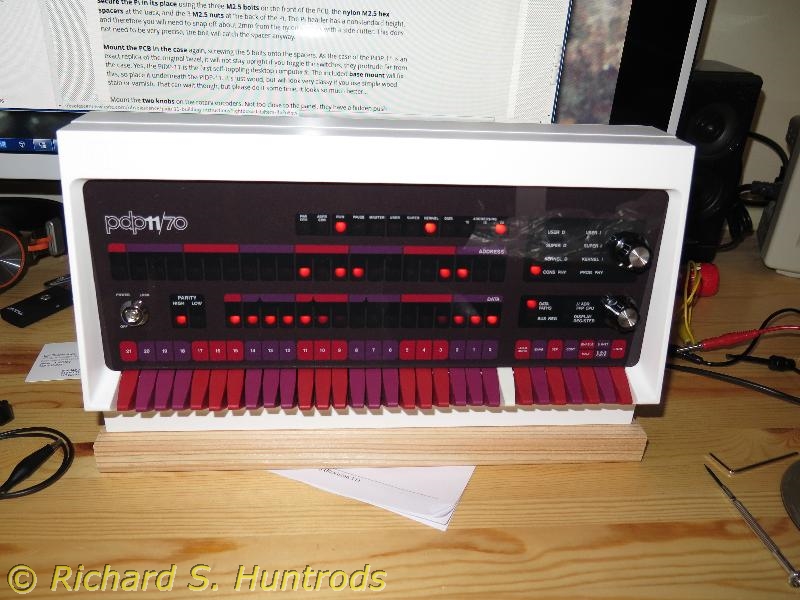I’m rapidly on my way to becoming an old codger. This Christmas Break I soldered together a couple of hardware kits that emulate some old and older computers. One was an Altair 8800 copy, which in it’s day was one of the very first “personal computers” ever sold. The other kit was a PDP11/70 replica, which was some of the first “big iron” I ever programmed on.
Now as testiment to my codgerhood, my first computer experience was at the UofC on a CDC Cyber 170, followed by the Honeywell Multics system that replaced the CDC at the UofC a few years later.
My first job post-graduation was at a company using two IBM 3033 mainframes, each of which filled a large room. The laser printer filled an equally large room, but that’ another story (it was VERY fast).
From there I worked with various other systems, including the above (actual) PDP 11/70’s and even at one point some time on a Cray YMP.
But this isn’t about “bit iron”, it’s about the personal computer. My first was a TRS-80 Model I. I bought a silk-screen expansion board, sourced and soldered it together as I could not afford the “offical” one. Later I bought a TRS80 Model III, then the 4 and finally a Model 4P, which I still have complete with all manuals and software.
But in amongst that time came the IBM PC. It changed the world simply because it was IBM and it seemed *everyone* (or every company) bought one.
I never owned an IBM PC, nor a clone PC. My first forray into “modern” (i.e. post-IBM) PC ownership came when Tandy brought out the Model 2000. This was based on the 80186 chip, which was a “hybrid” – not an 8086 and not an 80286, but something in between. It was a great machine, and much more affordable (for the time) than a “286”.
As I struck out on my own consulting, I bought one of the newest “386” machines, and it cost me $6000. But for the time it was the greatest, fastest machine you could buy.
I lived, worked, and owned PCs through the 486 era, and into the “Pentium” machines. By then the operating systems were firmly Windows based. I skipped Windows 1 through 3, but at Windows 3.1 it finally came into it’s own. Windows for Workgroups (WFW 4) was a really nice system at the time, and I did quite a bit of work on it.
Then came Windows 95, which “changed the world”. Certainly it brought the internet to the common computer owner, as well as a pretty decent OS. Buggy, but decent. Then came Windows 98 and Windows ME (pronounced “meh” – as in “what the hell is this piece of crap???”). By then I’d gravitated to Windows NT, which had one great feature – it worked and worked well.
Through this we had Pentiums. They got faster, but they were Pentiums.
Eventually sometime after 2000 Intel started putting out the I series – I3, I5, I7. Each one had more cores and was faster than the predecessor. AMD also had multi-core chips, and there was, for a time, a nice “arms race” of computing horsepower.
At the end of April, 2012, I built my current PC system. It uses an Intel Quad Core i7 3770K, Asus Sabertooth Z77 ATX motherboard, 16GB of RAM, a couple of fancy graphics cards, a fancy case with water cooling, 2 x SSD hard drives and a Blue Ray writer. All state-of-the-art for early 2012. I bought the components and assembled it myself, and it was (and is) a very nice system.
It was also considered very fast and high performance. That particular Intel I7 (3770K) was quad core, and fast.
But what I’ve noticed since then is… nothing. I *think* you can buy processors with more cores, and probably faster ones, but today I realized that although I still get tech-type feeds, I haven’t actually heard much in the past few years about “newer, faster, better” processors.
It’s as if we’ve exhausted that particular line of “faster, better” in personal computing. I suspect that for 99% of the market, ANYTHING you buy today is plenty fast enough. The other 1% is gamers, and perhaps if I got gaming feeds or magazines I would hear more about “faster gaming machines”, but I do wonder.
Have we really reached the end end of the “faster, better” in computing hardware?
I also wondered; if I wanted to find out what the FASTEST computer you could use today, how would I even go about finding it? Yea, there’s “the google”, but I’ve also started noticing that between all the “targeted results” based on what you like, it’s getting harder and harder to find any REAL information on the internet these days.
<sigh> I guess I really am becoming an old codger.

